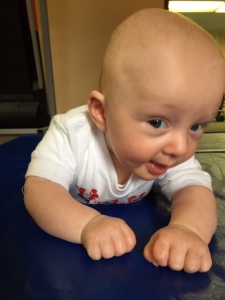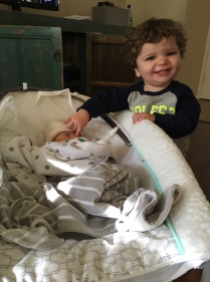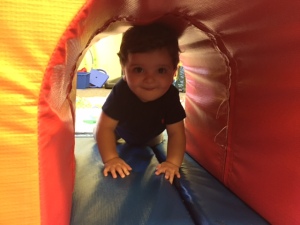
We relaunched our Developmental Playgroup this week and we broke it into smaller groups so that we could better direct our education and play activities. The first group is pre-crawlers and the second group is pre/early(new)-walkers. With our playgroup we spend time on a different developmental domain each week and this week’s topic was communication.
I wanted to share the information we gathered so that it can be passed along and shared!
6 stages of language development:
- Prelinguistic stage/ Pre-speech phase: first year of life.
- Development Aspects: development of gestures, making adequate eye contact, sound repartee between infant and caregiver, cooing, babbling and crying. Babbling is followed by jargon phrases- unintelligible strings of sounds with a conversation tone.
- Five stages of babbling:
- Phonation stage- 2mo: Cry, cough, grunt, sneeze- vocal cords are not vibrating with a smooth speech like quality yet. Vowel sounds.
- Gooing Stage- 2-3 mo: primitive movements of articulators (tongue and lips) become more coordinated- results in consonant like sounds- not fully formed. Start to coordinate sounds with eye contact. Start to take turns making sounds with caregiver.
- Expansion Stage- 4-5mo: ear fully resonant vowel sounds, explore pitch and intensity with squealing, yelling, growling, whispering and raspberries. Laughter emerges.
- Canonical Babbling- 6-7 mo: articulators, resonance and voice become coordinated resulting in real syllables. Quick to interpret this as attempts at words- Ba-Ba.
- Integrative/Jargoning 10-15 mo: complex babbling with a few real words thrown in. Intonation: gibberish with sound of comments, questions and commands. Well coordinated with gestures, body language and eye contact.
- Holophrase/ one word: 10-13 months
- One word can mean several different things- Dada (where is dada, dada come here, dada pick me up, etc)
- Two word sentence: 18 months
- Sentences are now a noun and a verb.
- Declarative: Doggy Big
- Interrogative: Where ball
- Negative: Not egg
- More milk: imperative
- Multiple Word Sentences: 2 and 2 ½ yrs
- Can use more prefixes/suffices, predicates in their sentences to change tense or meaning. Very common to have tense/grammar errors.
- Doggy is big, where is ball, this is not egg, I catched it, I falling.
- More complex grammatical structures: 2 ½ and 3 yrs
- Conjunctions, prepositions.
- Read it, my book, Where is Daddy, I can’t play, Take me to the shop.
- Adult like Language structures: 5 to 6 yrs
- Concepts such as ask/tell, promise, order in which words properly go in a sentence.
Milestones:
Year one
- Recognizes name
- Says 2-3 words besides mama, dada
- Imitates familiar words
- Understands simple instructions
- Recognizes words as symbols for objects: car- points to garage, cat- meows
- Understands no- 12-18 months
Activities: respond to child’s coos, gurgles, babbling, talk to your child throughout the day, read colorful books, tell nursery rhymes and sing songs, teach child names of everyday items and familiar people/label items, play peek a boo, pat a cake.
Between one and two:
- Understands no
- Uses 10-20 words, including names
- Combines two words (dada bye bye) – telegraphic speech
- Waves goodbye
- Makes the sounds of familiar animals
- Gives toy/item when asked
- Makes wants known- states more
- Can point to her toes, eyes and nose
- Brings objects from another room when asked.
Activities: reward/encourage early efforts of saying words, talk to baby about things that you are doing, talk simply, clearly and slowly, talk about new situations before, during and after, look at your child when they are talking to you, describe what your child is doing/feeling/hearing, listen to music.
Between two and three:
- Identifies body parts
- Carries on conversation with self and dolls
- Asks what that and where’s my
- Makes plurals- adding s
- 450 word vocabulary
- Gives first name and uses fingers to tell age
- Combines nouns and verbs- mommy go
- Understands simple concepts- last night, tomorrow
- Refers to self as me rather than name
- Tries to get adults attention- watch me
- Likes to hear the same story repeated
- May say no when they mean yes
- Talks to other children and adults
- Solves problems through words not hitting/crying
- Answers where questions
- Names common pictures/things
- Short sentences- me want more, me want cookie
- Matches 3-4 colors, knows big and little
Activities: repeat new words over and over, play games with following directions- touch your nose, go on trips and talk about what you see before, during and after the trip, let your child tell you the answers to simple questions, read books everyday make it a part of your routine, listen to your child, describe what you doing, have your child deliver simple messages mommy needs you daddy, carry on a conversation with your child, ask questions to get your child to think/talk, show the child you understand by answering smiling and nodding your head, expand what the child says- dog big- that is a big brown dog.
Language development supports your child’s ability to communicate, and express and understand feelings. It also supports thinking and problem-solving, and developing and maintaining relationships. Learning to understand, use and enjoy language is the critical first step in literacy, and the basis for learning to read and write.
Interactive Reading: ask questions, use dramatic inflections, let them guess what will happen next, point to pictures and describe them- ask your child to do the same.
References:
1. http://raisingchildren.net.au/articles/language_development.html
2. https://childdevelopmentinfo.com/child-development/language_development/
3. http://www.asha.org/public/speech/development/language_speech/
4. http://www.asha.org/public/speech/development/01/
5. http://www.asha.org/public/speech/development/12/
6. http://edubloxtutor.com/language-development/
7. http://www.ldonline.org/article/6313
8. http://www.speech-language-therapy.com/index.php?option=com_content&view=article&id=35:admin&catid=2:uncategorised&Itemid=117
9. http://www.speech-language-therapy.com/index.php?option=com_content&view=article&id=34:ages&catid=11:admin&Itemid=117
10. http://www.sentinelsource.com/parent_express/pregnancy_babies/understanding-the-stages-of-baby-babble/article_611d18f4-a11d-11e1-8120-0019bb2963f4.html
















